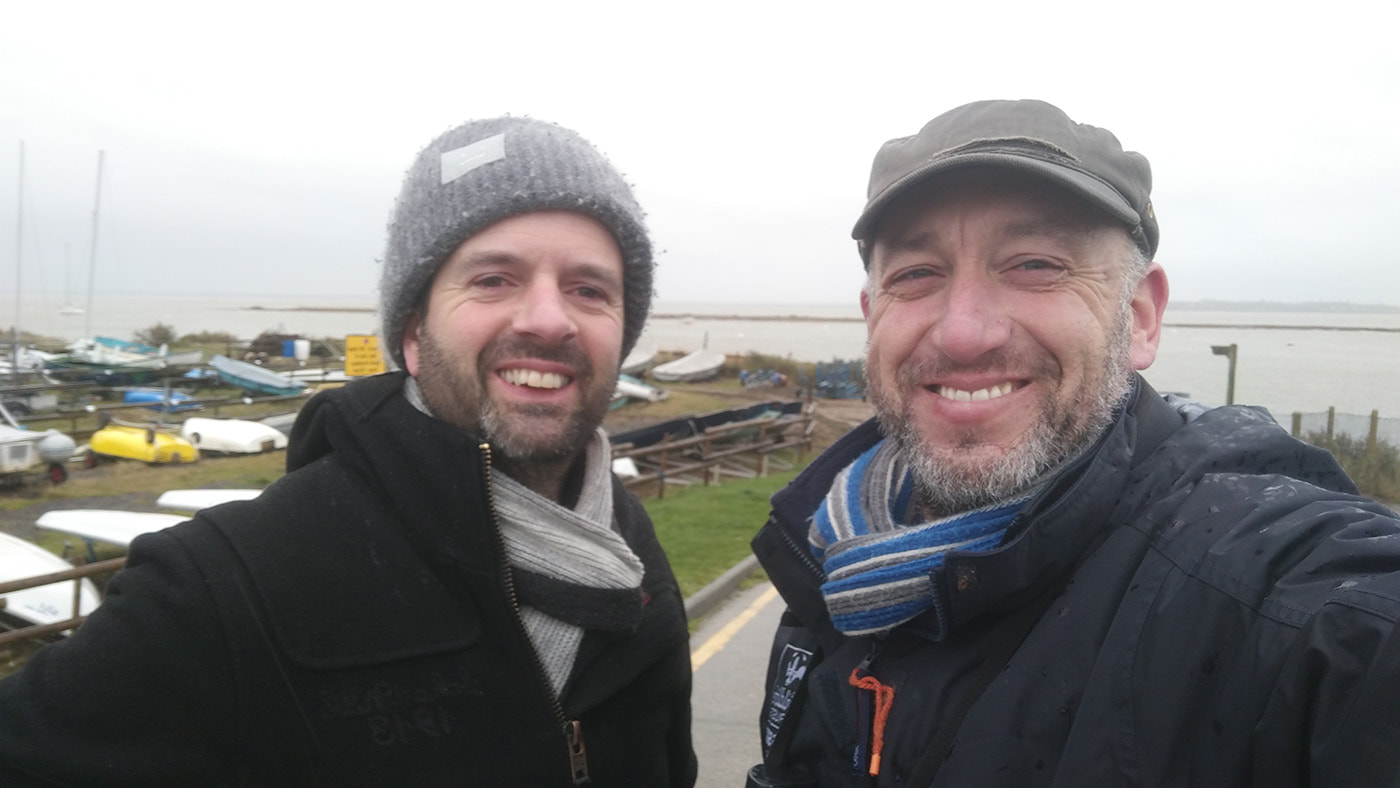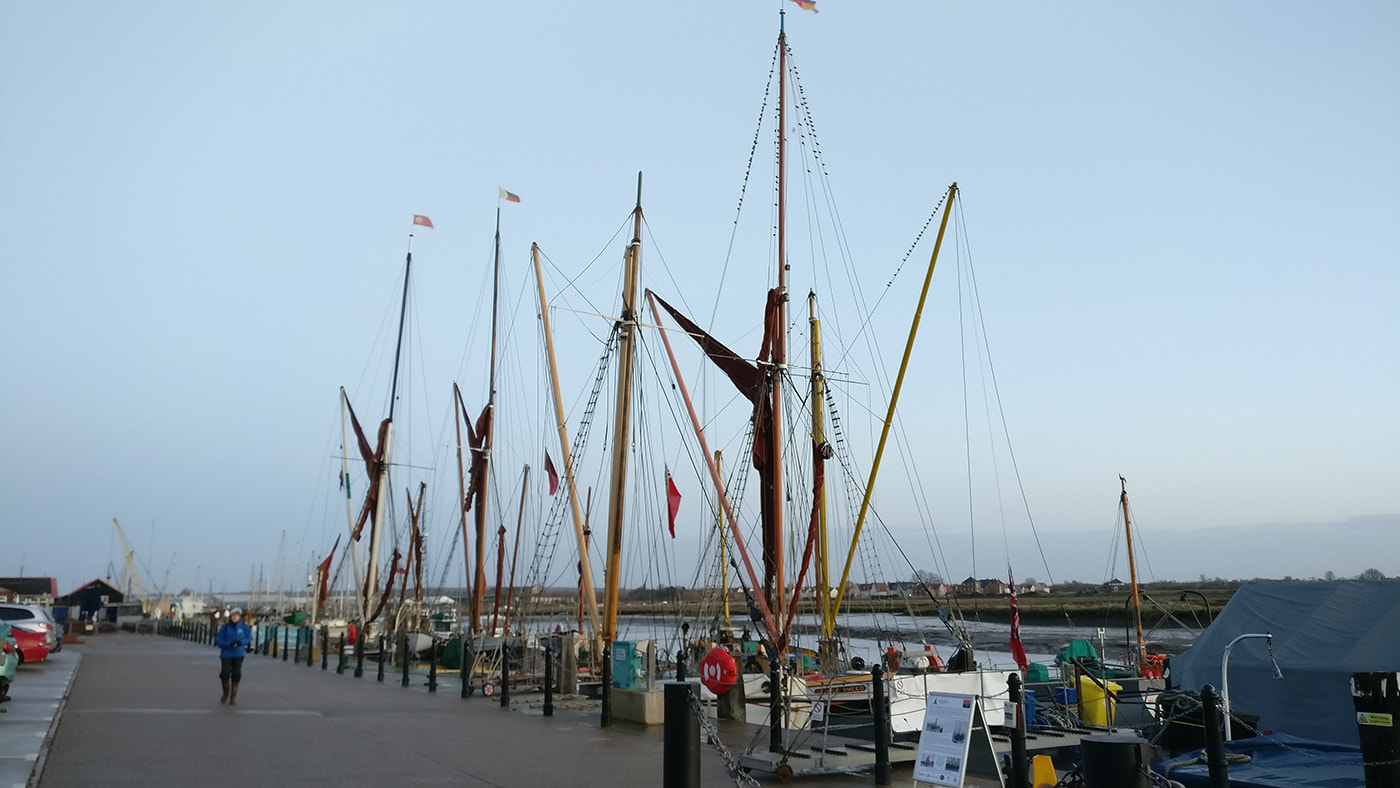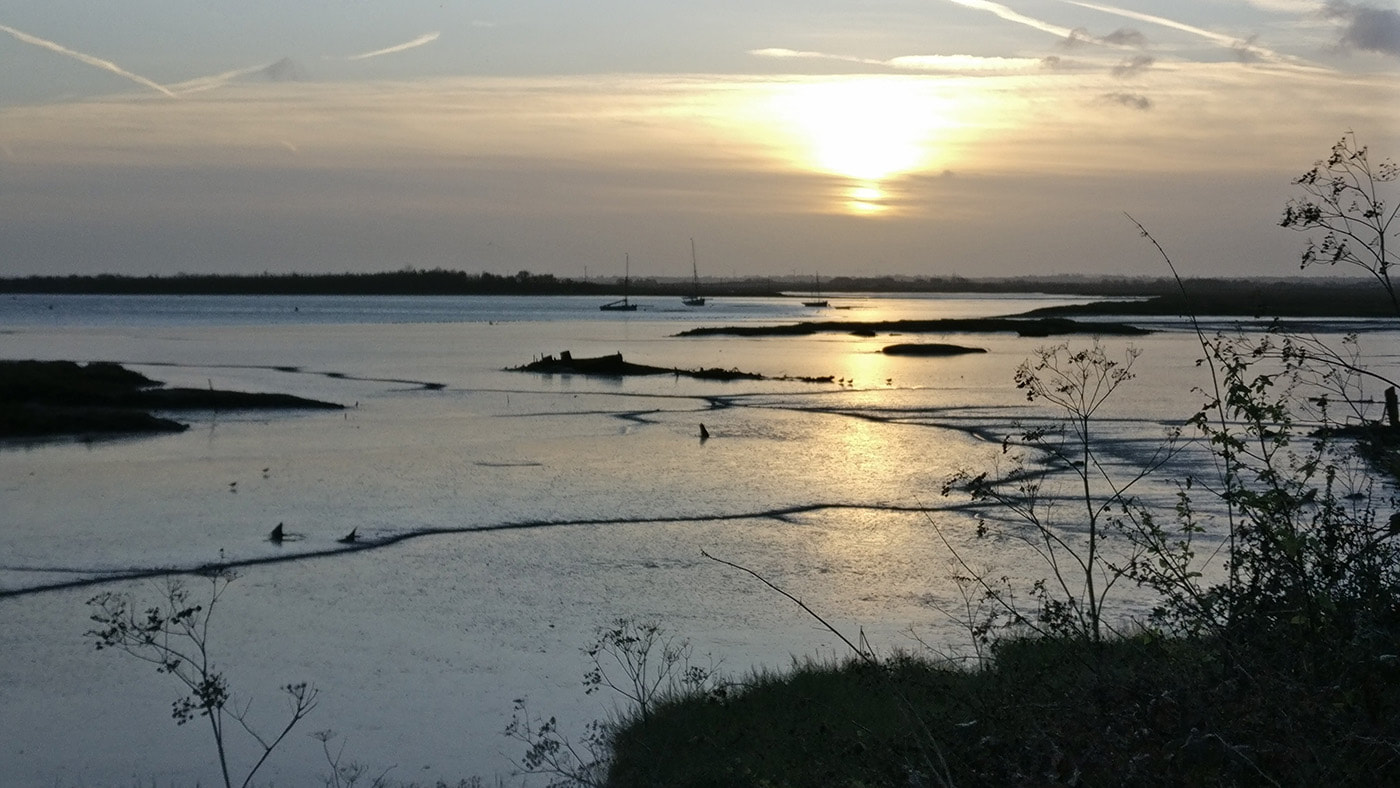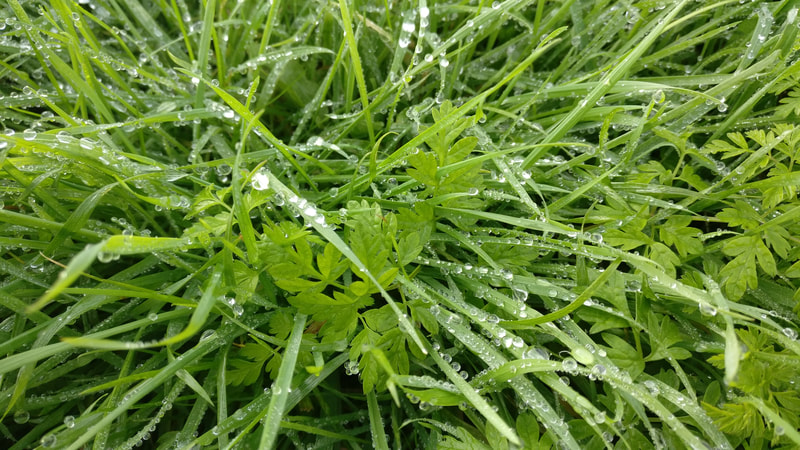|
Today I went for a walk with Marc Outten, Reserves Manager with the Essex Wildlife Trust, along the coastal path from Bradwell Riverside around the top of the Dengie peninsula to St.Peter’s Chapel, to discover what inspires him to take such a keen interest in the natural world and, of course, to see what birds we could spot. It was reasonably windy, and rain was forecast but we agreed to continue anyway and almost immediately Marc spotted a Cetti’s Warbler in the hedges. He has had a keen interest in birds since he was a small boy and owned a pair of binoculars since the age of 7 and it certainly showed as he identified a whole host of birds within the first 50 meters of the sea wall. Over the course of the last few projects I have been involved in, including The River Runs Through Us (with Ruth Philo) and River of Words I have met a great deal of people who have a love of the natural world and a passion for the conservation of it. Whether that be in a professional role or as an enthusiast, a lot of people enjoy the beauty and freedom of being out of doors. There is an increasing acknowledgement that being outside, and within the natural environment, is good for us on many levels, keeping our minds and bodies fit, but also on a more existential level by connecting us to the place and time in which we live. Many people however do not engage with their local surroundings, wildlife, the weather, and society as a whole has in fact become less connected with the natural world, and therefore, the consequences upon it of our actions. I could of course include myself in that but in recent years I have made a concerted effort to re-engage, to slow down, stop for a while, listen, look, absorb. Marc seemed thoroughly engaged, not only with birds that we could see, but with wider land usage, erosion, climate change, birding and twitching networks, annual and seasonal cycles, different habitats and plants. He spoke passionately and knowledgeably about all of these topics as we walked beside the river and towards the sea, and I’ll be expanding on some of these themes later in the blog. We did not see the Peregrines today, which was a touch disappointing, but we did see a Kestrel hunting on the sea wall for quite some time, and at close quarters, which was impressive. As we rounded the corner to head south, the weather started to close in and the cold rain became more driving. Taking notes became more difficult (I had to dry my notebook out on a heater) and photos even more so. We did however see quite a few more birds at close quarters, including Reed and Corn Buntings, which made me happy as I confirmed that the birds I had seen before at Tollesbury were indeed Corn Buntings. We also saw a rock pipit, which, as a small brown bird, was indicated mainly by its behaviour and the setting in which it was seen.
All in all we had a great walk and I learned a lot about the landscape and wildlife around us. The work of Marc, the Essex Wildlife Trust and many like them cannot be underestimated and their roles seem increasingly important as pressures mount both ecologically and politically. We could certainly all help them by doing something positive in our everyday life to contribute to the solution, and not the problem. Not all of my expeditions to the River Blackwater will be to record sound. Some will be to walk with local people or others with specific interests, such as birds or ecology. I have never been very good at learning in formal situations or by studying, but I do learn much more easily by talking to people, watching and listening, or just getting involved with something. Today I went for a walk with Susannah Robirosa who has been a keen birder for some time and whose bird spotting knowledge and skills I was hoping to learn from. Being a Sunday the traffic enable us to arrive in good time and dawn hadn’t even arrived as we set off from The Hythe in Maldon. Instantly there were plenty of birds to identify, some of which I could but there were plenty that I couldn’t. Even seeing the amount of different birds was at first difficult, but as Susannah explained the differences between them they became easier to spot. Not only markings but behaviours can be taken in to consideration, as well as understanding the difference between male and female markings and summer and winter plumage. After walking along the promenade for a while we turned off and followed the foot path behind the boat club and alongside the large expanse of salt marsh which at low tide was a haven for many birds on the exposed mud and low lying grasses and other plants. The path was muddy and a bit difficult to traverse but we made it as far as South House Chase spotting birds all of the way. Northey Island has a causeway to access it but the water looked a bit too deep to cross so we stopped and had a cup of tea and a Danish pastry whilst sitting on an old piece of concrete next to the water. The sun was now up and the light streaming across the marsh was an intense yellow, highlighting grasses and bringing a slight warmth to our faces. As we sat there discussing the difference between Twitchers and Birders, and how the changing magnetic field might affect bird navigation, we noticed that the tide had turned and was starting to come back in so we were very pleased that we hadn’t crossed on to the island.
The walk back was a bit windier and colder than earlier, but as with all return journeys they seem shorter and before we knew it we were back in the town and heading to the Barge Tearooms for a warm cuppa. We both agreed that it was a very fruitful three hours and we’ll definitely go out again at some point in the future. Here’s what we saw: Gadwall, Starling, Moorhen, Avocet, Little Grebe, Teal, Widgeon, Godwit, Dunlin, a variety of Sandpipers, Canada Goose (with a Domestic Goose that had joined the flock), Plover, Curlew, Redshank, Greenshank, Little Egret, Kingfisher, Crow, Mallard, Black Headed Gull, Barnacle Goose, Cormorant, Shelduck and possibly a Meadow Pipit.
Today was the coldest day so far of the project, but the 2km walk down Church Street in Tollesbury to the sea wall soon generated some heat. The puddles were iced over but many of them had been broken by the tractor that had passed me in the opposite direction. The driver returned my wave, a gesture of acknowledgment, of our presence in that place at that time. There were quite a few birds in the hedgerows, but I could only identify blackbirds until I reached the point of the path where it forks, and I headed left. Two buzzards took off from the field and slowly soared up and away, heading gently north.
Being mindful of my clumsy entry in Maylandsea, I walked slowly and carefully as I got closer to the river, but my quiet and gentle movements were somewhat derailed by three dogs greeting me in a flurry of fur. ‘’Sorry about that’. ‘Morning. It’s fine.’ I proceeded and noticed that there was an incline, probably made for a motorised vehicle, sloping up from the lower level of the land to the higher level of the sea wall, so I stopped at the bottom of it and assembled my kit. I was unsure as to the state of the tide, and if there were any exposed areas of mud where birds might be, but I could hear some geese and a wading bird on the other side. I slowly crept up behind the iron defences and placed my tripod just behind it, but high enough that it would capture the sound of the river directly. A quick peek was all that I risked and I could see that the tide was heading out to reveal some mud and rocks, where some birds had gathered, including an Oystercatcher and some Brent Geese. I sat on my chair midway down the incline, facing inland this time, and waited.
Most of the sonic activity came from the river and I could hear several birds calling, and a flock of geese passing, with only a few gulls and a couple of crows passing past on the land side for quite some time. Baker mentions that he always wore the same clothes when out birdwatching, which would identify his as a certain person in the eyes of the Peregrine, so I have decided to follow his advice. The coat that I prefer to wear for recording in the winter isn’t waterproof, but I think that this gives it a distinct advantage as its very quiet and doesn’t rustle, which enables me to make notes or move about slowly with much less chance that I may record myself if I’m in close proximity to the mics. It’s not always possible to remove oneself far enough away from the mic whilst recording, especially in my experience of recording mostly urban environments, although I have found this easier in the rural environment.
Bird scarers go off occasionally, doing their job and sending up birds from their grazing time. But this can be a serious problem for their energy levels if the birds spend too much time flying and not enough eating. Between the aircraft passing over head I see two men walking this way down the path, but they walk directly up on to the sea wall and head the other way, west, along the river. Their visibility immediately startles the birds who give out warning calls. The men have binoculars on a monopod but don’t stick around long before heading off. Then all settles down to become quiet again. A few flocks of small birds playfully fly back and forth but I can not identify them. Using the RSPB book they look like a Reed or Corn Bunting but as they’re pretty rare I’m rather doubtful. A (probably) husband and wife couple approach with their binoculars in hand and ask if have seen anything interesting. They had also seen the buzzards but nothing els remarkable, although I would have like to have asked them what the mysterious Bunting like birds was, but they were now nowhere to be seen. We chatted for a while about recording sound, the tide, Twitchers and birdwatchers, Tollesbury and the local paths. As they headed off again they said that they would stay below the sea wall so as not to disturb any birds and actually walked quite a way before scaling the sea wall to get a view of the river, whcih was very kind of them. I was slightly dejected after having not observed all of the birds on the river, especially as there wasn’t so many birds in land, but on the way back I saw quite a lot more birds including Fieldfares, Sparrows, more of the Bunting like birds, a goldfinch and most impressively, at about 15 meters distance, a female Sparrowhawk who very calmly drifted past |
Details
AuthorInspired by J A Baker's The Peregrine, recording the sonic landscape around the River Blackwater, Essex. Funded by Arts Council England's Develop Your Creative Practice grant 2019 - 2020. Archives
December 2023
Categories |















 RSS Feed
RSS Feed
